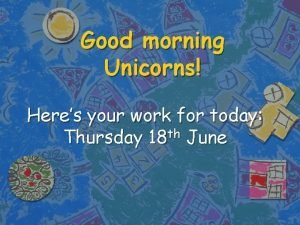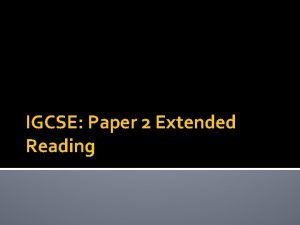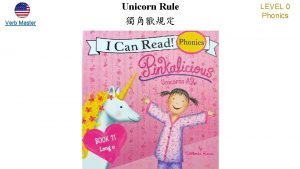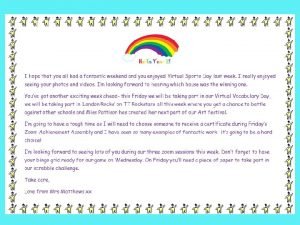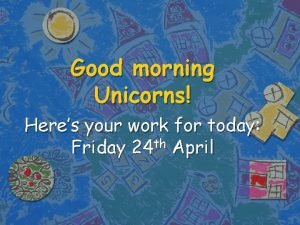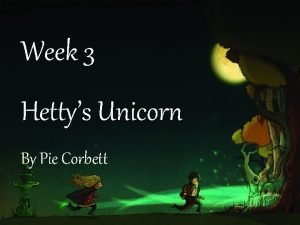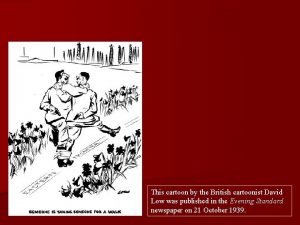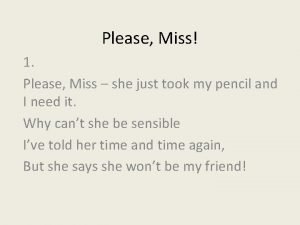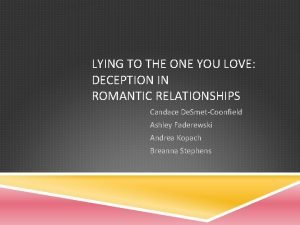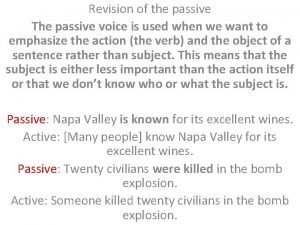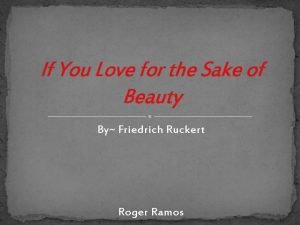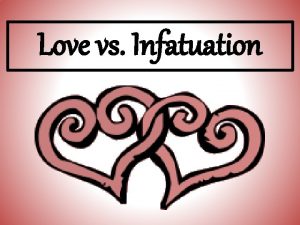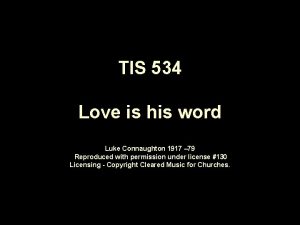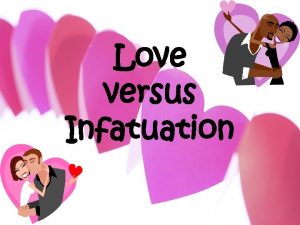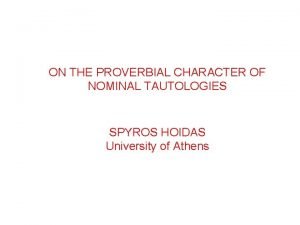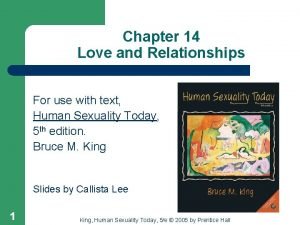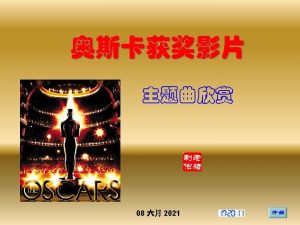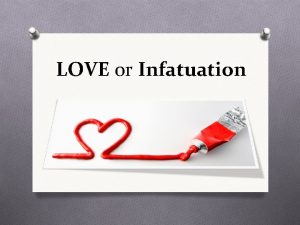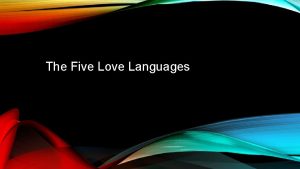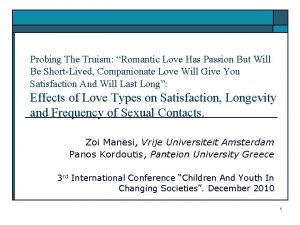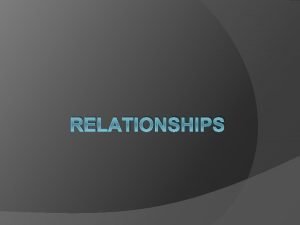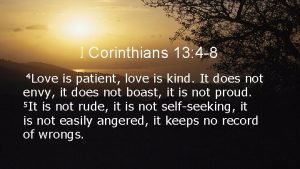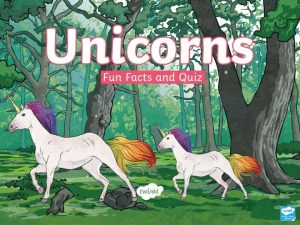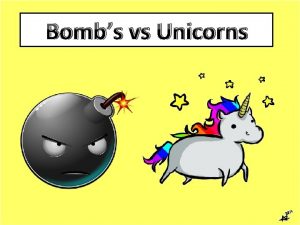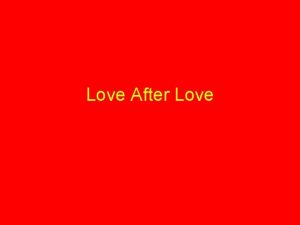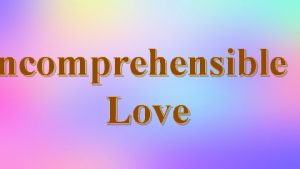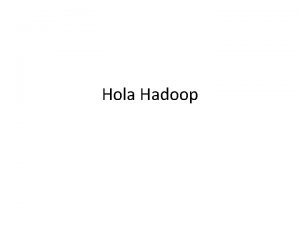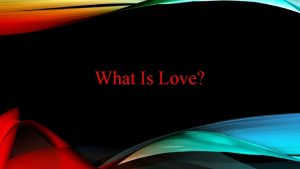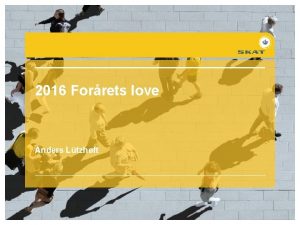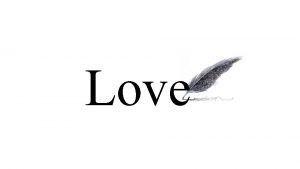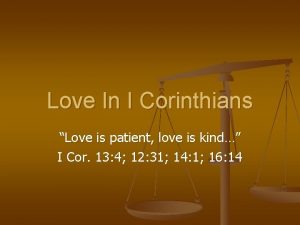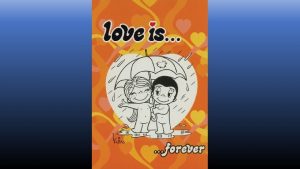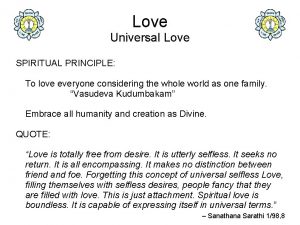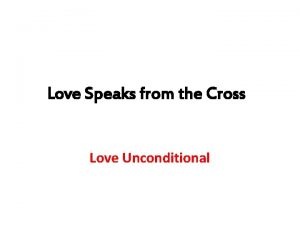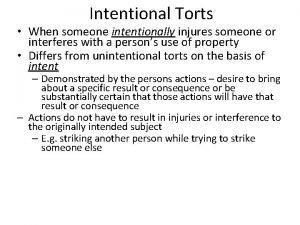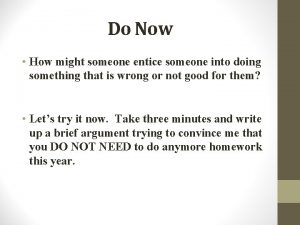FOR THE LOVE OF UNICORNS WILL SOMEONE PLEASE























































- Slides: 55

FOR THE LOVE OF UNICORNS WILL SOMEONE PLEASE EXPLAIN MODELS &THEORIES? A Media Influence Revision Power. Point.

APPROACHES, THEORIES &MODELS Academic Approach: overarching idea or ‘umbrella term’ for the way media influence has been thought about over the years. Theories and models exist within these approaches. � Political Economy, Effects Tradition & Cultural Studies � Note: Political Economy and Cultural Studies are both called models (e. g. Political Economy Model) but they are actually approaches. As far as I can tell this is purely to mess with your head, so just leave the word ‘model’ off the names or replace it with ‘approach’. Theory: idea or set of principles about how something works. They frame the way we look at the world but do not dictate it (i. e. they cannot be 100% verified, otherwise they would be rules). � Hypodermic Needle, Agenda-Setting Function, Cultivation, Reinforcement, Two-Step Flow, Uses & Gratification. � Model: visual or verbal image of how something works. � � They explain how something works. Laswell, Shannon Weaver, Schramm, Two-Step Flow, Multistep Flow, Propaganda.

FROM THE VCAA STUDY DESIGN: “Theories of media influence and communication models are underpinned by academic approaches…” (pg 28) Academic Approach Theories Models Evidence

APPROACHES

EFFECTS TRADITION What the media does to people. Media content can actually cause a change in the behaviour of individuals in a society (so sometimes called a ‘behavioural approach). Tend to use simple models of communication based on a straight line between the sender and receiver. The media is a powerful agent of change. Theories: Hypodermic, Agenda-Setting, Cultivation. Models: Laswell, Shannon Weaver, Schramm.

CULTURAL STUDIES Culture (including political economy & the media) explains the individuals’ relationship with the media. Media serves as the communicative space within which cultures and other forces in society can interact. Theories: Reinforcement, Two-Step Flow, Uses and Gratification Models: Two-Step Flow, Multistep Flow, Encoding/Decoding Model

POLITICAL ECONOMY Media are simply part of an economic system where power and control reside in political and economic institutions. Media transmit the messages that these institutions determine. Theories: N/A Models: Propaganda Links to ideas of media ownership and regulation

THEORIES

TYPES OF THEORIES Effects Theories: What the media does to people � Concentrate on the media message � Try to find out whether the media changes peoples’ behaviour � Hypodermic, Agenda-Setting Function, Cultivation � Reception/Constructivist Theories: What people do with media � Try to find out how people make sense of the media (i. e. how media is received) � Audience is seen to be constructing their own meanings from the text � Reinforcement, Two-Step Flow*, Uses and Gratification � *Two-Step Flow is a limited effects theory, so it almost sits under both theory types

HYPODERMIC NEEDLE THEORY (1920 S-40 S) Also known as Magic Bullet Theory Proposed by various theorists. Effects theory that suggests mass media has a direct, immediate and powerful effect on its passive audiences. Mass media could influence a very large group of people directly and uniformly by ‘shooting’ or ‘injecting’ them with messages designed to trigger a desired response. The audience are ‘sitting ducks’, unable to distinguish fact from fantasy

HYPODERMIC NEEDLE THEORY STRENGTHS &LIMITATIONS Strengths: � N/A Limitations: � Overly simplistic description of media influence � Suggests that all audiences respond to media texts in exactly the same way � Based on anecdotal observations and assumptions instead of scientific research � Debunked

HYPODERMIC NEEDLE THEORY EXAMPLES War of the Worlds (1938) TAC advertisements Banning of confederate flag Columbine High School Sydney Lindt Café Seige

AGENDA-SETTING FUNCTION THEORY (1972) Proposed by Maxwell Mc. Combs and Donald Shaw. Effects theory that suggests the media cannot tell us what to think, but it can tell us what to think about. Media has the power to set the agenda (terms of reference) for any social, political or economic issue. Media can give one side of a story prominence over another by selecting what will be reported and what will be omitted. Media does not reflect reality but instead filters and shapes it in the eyes of the audience.

AGENDA-SETTING FUNCTION THEORY (1972) Agenda-setting function operates on two levels: Basic agenda: media tells audience what to think about by selecting certain topics and not others. � Tone of the agenda: media sets the tone for the way audiences will think about topics by adopting a negative or positive voice or by showing some sides of the topic and not others. � Whether unintentionally or not, the media use the following processes to set the agenda: Gatekeeping: media (or individuals within media) decide which topic/s will be ‘granted entry’ (featured) or not. � Priming: media kick-start certain issues by ‘pumping them up’ or priming them. � Framing*: media encourage audiences to think about topics a certain way by packaging or ‘framing’ the information to be positive or negative. � *Mc. Combs added this when he revised theory in the 1990 s. �

AGENDA-SETTING FUNCTION THEORY STRENGTHS &LIMITATIONS Strengths: � Explains how media can influence society/culture � Explains why some people are influence by media and others (who are less exposed to media) are not � Very effective at explaining news media Limitations: � Less relevant in modern, fragmented media � Less relevant for new media, where audiences are able to set their own agenda

AGENDA-SETTING FUNCTION THEORY EXAMPLES Hands-only CPR Kylie Effect Ebola The Ice Bucket Challenge Bring Back Our Girls I’ll Ride With You I Quit Sugar/That Sugar Book Meningococcal Depression/Mental Health/Man Therapy/Beyond Blue

CULTIVATION THEORY (1970 S-80 S) Proposed by George Gerbner. Effects theory that suggests media exposure, specifically to television, shapes our social reality by giving us a distorted view on the amount of violence and risk in the world. The more time people spend “living” in the television world, the more likely they are to believe the reality being portrayed on television. Television colours our perception of the world. Because TV often portrays stereotypes, this can result in people believing these inaccurate stereotypes to be true.

CULTIVATION THEORY (1970 S-80 S) Mainstreaming: television flattens out differences between ways of thinking in society to create a broad middle-ground. Resonance: effect of a television program is much stronger if viewer has had a similar experience to the one being portrayed. Mean world syndrome: viewers develop a distorted view of the world as more violent and dangerous than it actually is due to the cultivation of negative portrayals on television – they believe television reflects real life rather than grossly exaggerating it.

CULTIVATION THEORY STRENGTHS &LIMITATIONS Strengths: � Shows connection between beliefs held by audience and the representations depicted on television � Reliably supported by large scale studies and statistics Limitations: � Still essentially operates under the assumptions of Hypodermic Needle Theory � Ignores audiences and texts by focusing on statistics � Effects that have been found are statistically small

CULTIVATION THEORY EXAMPLES Body image Portrayal of racial minorities Mental illness

REINFORCEMENT THEORY (1960) Sometimes considered to be an example of a limited effects theory, other times a reception theory. You choose. Proposed by Joseph Klapper. Reception/constructivist theory that suggests people seek out programs and information that reinforces their existing views. Media has little power to change people’s opinions, they are more likely to be influenced by their existing circles of friends and acquaintances. � Most powerful influences: church, family and school.

REINFORCEMENT THEORY – KEY IDEAS Cognitive Dissonance: When new information clashes with existing beliefs it creates cognitive dissonance, which is an unpleasant feeling. Selective Exposure: To alleviate/avoid cognitive dissonance, people seek information that supports their existing beliefs. Selective Retention: People remember only the information that agrees with their own views. New Ideas: Audience are affected more strongly by new ideas in the media as they have not encountered them before and do not have pre-existing mindsets. Open Texts: There can be multiple interpretations of a single text, people interpret according to their own beliefs and therefore see their own reinforced version of the story.

REINFORCEMENT THEORY STRENGTHS &LIMITATIONS Strengths: � Explains why political campaigns often fail to change people’s minds � One of the first theories to acknowledge that audiences have power to decide meaning of texts Limitations: � Downplays media influence too much � Modern children are strongly influenced by media and less so by family or church � Less effective at describing effects of new media

REINFORCEMENT THEORY EXAMPLES Political campaigns 1970 s study on ‘All in the Family’ Body Image (e. g. people convinced that it is still fashionable to be thin, or tanned, will select information from such sources as social media, to reinforce this attitude – Kendyl M. Klein, 2013) Beck and Jennings study (most 18 year olds will vote the same as their parents, rather than be influenced by the media)

TWO-STEP FLOW THEORY (1940 S) Sometimes called ‘limited effects theory’. Can be referred to as either a theory or a model – see Two-Step Flow Model slide for more information. Proposed by Paul Lazarsfeld. Media works in two distinct stages. 1. 2. Opinion leaders (knowledgeable peers) absorb the media message and adapt it to their own beliefs and values. Opinion leaders pass the slightly altered message on to others in their social networks (note: they are leaders of their specific group only).

USES AND GRATIFICATION THEORY (1974) Proposed by Jay Blumler and Elihu Katz. Reception/constructivist theory that suggests audiences are active participants in the communication process. Audiences choose media texts to gratify their own needs, e. g. the need for information, personal identity, integration, social interaction or entertainment. Media consumers have a free will to decide how they will use the media and how it will effect them. Recognises that audiences are active participants in the communication process.

USES AND GRATIFICATION THEORY (1974) There are four areas in which the audience can achieve gratification: Diversion and escape: media can help people to relax and escape their personal pressures. � Companionship: media can enhance personal relationships by giving people something to talk about. � Personal identity: media can help people to build up a sense of who they are through their consumer choices and by allowing them to find reflections of their own lives. � Surveillance: media enables people to keep in touch with changes and opportunities. � A further four categories of uses were added by Professor Alan Rubin of Kent State University: passing time, enjoyment, relaxation and excitement.

USES AND GRATIFICATION THEORY STRENGTHS &LIMITATIONS Strengths: � Emphasises an active audience � Combines qualitative data (interviews and diaries) with quantitative data (statistics) in its research Limitations: � Dehumanises viewer by reducing them to a set of needs � Ignores media power � Assumes audiences always find positive uses for media – ignores dysfunctional and anti-social uses

USES AND GRATIFICATION THEORY EXAMPLES Social media � � � http: //tigger. uic. edu/~zizi/Site/Research_files/Newer. Sociability. Me dia. Perspectives. pdf http: //digitalcommons. liberty. edu/cgi/viewcontent. cgi? article=142 6&context=doctoral http: //www. anzmac. org/conference_archive/2005/cd-site/pdfs/3 Consumer-Beh/3 -Price. pdf Never Ending Friendling (My. Space research) Why Youth (Heart) Social Network Sites – ethnographic research by Danah Boyd: http: //www. danah. org/papers/Why. Youth. Heart. pdf Viewer Aggression and Attraction to TV Talk Shows � http: //www. researchgate. net/publication/247503427_Viewer_Agg ression_and_Attraction_to_Television_Talk_Shows

MODELS

LASWELL MODEL (1948) Developed by Harold Laswell, an American political scientist. Linear effects model. Five key questions allowed people to study/explore each stage of the communication process in isolation whilst still considering each stage to be part of the overall communication process.


LASWELL MODEL STRENGTHS &LIMITATIONS Strengths: � Simple and straightforward � Suitable for most types of communication � Considers effect Limitations: � Does not include feedback option � Does not consider noise/interference � A purely linear model

LASWELL MODEL EXAMPLE CNN News: A water leak from Japan’s tsunamicrippled nuclear power station resulted in about 100 times the permitted level of radioactive material flowing into the sea, an operator at Tokyo Electric Power Co. said on Saturday. Who: TEPC operator What: Radioactive material flowing into the sea Channel: CNN News (television medium) Whom: Public Effect: Alert the people of Japan

SHANNON WEAVER MODEL (1949) Developed by Shannon Weaver, who worked for the Bell telephone company. Linear effects model that deals with the transmission of information, rather than communication as we understand it today. Proposes six stages between the source and the receiver: source, encoder, message, channel of communication, decoder, receiver (initial model did not include feedback loop).

SHANNON WEAVER MODEL (1949) First model to recognise that the message sent from the source may not be the same message received/decoded by the audience. Interference may occur during the sending of the message along the channel of communication. This interference may be in the form of semantic noise, for example: � Audience being distracted; � Differences in use or understanding of codes of communication; � Audience misinterpreting the message; � Impact of audience attitudes towards the sender and the message.

SHANNON WEAVER MODEL STRENGTHS &LIMITATIONS Strengths: � Simple and straightforward � Easily applied to many communication methods � Considers noise and feedback Limitations: � Less effective for describing mass communication � Communication is not a one-way process � Less useful in modern communication where the process is no longer linear (e. g. online access at any time, multiple authors/senders, information on demand)

SHANNON WEAVER MODEL EXAMPLE Damo asks Dazza if he can borrow an esky but Dazza isn’t paying attention so he has to repeat the message. Source: Damo Encoder: Damo (puts message into words…ish) Message: “Oi, bros! Gimme ya esky! Nah, go on!” Channel: face-to-face � � Noise: Damo is not paying attention, only hears “… go on!” Feedback: Damo says, “Huh? ” which prompts Dazza to repeat the question. Decoder: Dazza (understands Damo’s words) Receiver: Dazza Note: If Damo rang Dazza or texted him, the Encoder would be Damo’s phone, the Channel would be the phone network and the Decoder would be Dazza’s phone. Note 2: If Dazza had not heard the message clearly the second time, or had made an error in decoding it, he would have misunderstood and therefore received a different message to the one that Damo sent.

SCHRAMM’S MODEL (1954) Developed by Wilbur Schramm. Circular model built on the work of Shannon Weaver. Proposed that communication is a two-way process (includes feedback) between sender and receiver and introduced ‘field of experience’. Each person in the communication acts as both sender and receiver, therefore both must interpret a message.

SCHRAMM’S MODEL (1954) The source first encodes the message and then sends it to the receiver, who must decode and then interpret the message before responding (feedback) by sending their own message in return. Interpretation may be influenced by noise (physical or semantic). � Feedback may be direct (immediate), moderately direct or indirect (delayed). � E. g. face-to-face conversation provides direct feedback; staring at the wall during a boring lecture is giving moderately direct feedback; a teacher who sees the result of their lessons in the end-of-year exams is receiving indirect feedback. � The meaning of a message may be denotative (common, dictionary meaning) or connotative (evaluative, based on individual experience). � For understanding to take place, they must have something in common – their fields of experience (individual beliefs, values, experiences and learned meanings) should overlap.

SCHRAMM’S MODEL STRENGTHS &LIMITATIONS Strengths: � A more practical model of communication � Shows how situation/communication can change � Feedback is a central feature � Focuses on interpretation of meaning rather than the transmission channel � Considers influence of personal experience, culture and context on interpretation of a message Limitations: � Suggests that sender and receiver take turns to send/interpret messages � Less effective for describing mass/complex communication

SCHRAMM’S MODEL EXAMPLE Sunshine-Rose, an American backpacker, is out clubbing with some fellow tourists. As she tries to enter one club, the security guard informs her that thongs are not allowed. She promptly slaps him in the face and screeches that her thong is none of his business. Initial Source: Security guard Encoder: Security guard puts message into words Message: “Thongs are not allowed” � In this scenario the meaning of the message is connotative because Sunshine-Rose and the security guard do not share a common field of experience. Channel: face-to-face Decoder: Sunshine-Rose understands the words Interpreter: Sunshine-Rose interprets “thongs” as ‘underwear’ rather than ‘flip-flops Message (immediate feedback): Sunshine-Rose slaps the security guard Decoder: Security guard understands that he has been slapped Interpreter: Security guard realises that Sunshine-Rose has misunderstood his initial comment. *Both Sunshine-Rose and the security guard act as sender and receiver of messages.

TWO-STEP FLOW MODEL (1940 S) Developed by Paul Lazarsfeld & Elihu Katz Limited effects paradigm that suggests media works in two distinct stages. 1. 2. Opinion leaders (knowledgeable peers) absorb the media message and adapt it to their own beliefs and values. Opinion leaders pass the slightly altered message on to others in their social networks (note: they are leaders of their specific group only).

TWO-STEP FLOW MODEL STRENGTHS &LIMITATIONS Strengths: � Recognises indirect nature of effects. � Recognises role of audience interpretation. � Recognises that audiences are active. Weaknesses: � Seems to assume there are only a few media outlets (due to its 1940 s origin). � Despite recognising that audiences are active, seems to suggest that only some audience members are. � Unable to prove that opinion leaders are different from anyone else.

TWO-STEP FLOW MODEL EXAMPLE Shaniqua is watching ‘Today Tonight’ and sees a story that claims immunising children causes ADHD. She calls Skylah, Shiraz and Rybekkah to warn them and they all decide not to immunise their children. Mass media: Today Tonight. Message: immunisations cause ADHD in children Opinion leader: Shaniqua. Individuals in contact with leader: Skylah, Shiraz and Rybekkah.

MULTISTEP FLOW MODEL (1987) Developed by Denis MCQuail. An extension of the Two-Step Flow Model. Messages may be carried between audience members who have no direct contact with the media or opinion leaders.

MULTISTEP FLOW MODEL EXAMPLE Shaniqua is watching ‘Today Tonight’ and sees a story that claims immunising children causes ADHD. She calls Skylah to warn her, then Skylah texts Shiraz who then shouts it over the back fence to Rybekkah. They all decide not to immunise their children. Mass media: Today Tonight. Message: immunisations cause ADHD in children Opinion leader: Shaniqua. Individual in contact with leader: Skylah Isolated individuals: Shiraz and Rybekkah.

ENCODING/DECODING MODEL (1970 S) Developed by Stuart Hall. Accepts that the media are powerful but argues that this power is never complete – it is constantly struggled for and negotiated with the audience. Meaning of a text lies somewhere between the producer and the audience – not fixed (hypodermic) but not so fluid/open that it can mean whatever anyone wants it to.

ENCODING/DECODING MODEL (1970 S) The media places specific and intended meanings in texts through encoding. Audiences make their own sense of these texts through decoding. Audiences may derive three possible meanings from a text: � Dominant Reading: the intended meaning sent by the producer (preferred reading). � Negotiated Reading: partially accepts preferred reading but may resist/modify message to reflect own position, experiences and interests. � Oppositional/Resistant Reading: understands preferred reading but rejects it.

ENCODING/DECODING MODEL STRENGTHS &LIMITATIONS Strengths: � One of the most influential models � Indicates an active audience Weaknesses � Assumes a singular dominant meaning embedded in the codes of a text, does not consider the possibility of a text presenting conflicting meanings � Some critics argue that the dominant reading may not be coded in the text, but rather is a reflection of dominant culture at the time of reading � Can potentially stereotype audiences due to limitations of three readings

ENCODING/DECODING MODEL EXAMPLE “A media literate person can decode, evaluate, analyse and produce both print and electronic media” (Aufderheide, 1997) Social Media Decoding Dictionary for Parents � http: //www. thedigitalmarketingbureau. com/2015/09/07/5 5 -five-top-digital-marketing-news-stories-in-5 -minutes 7 th-september-2015/

PROPAGANDA MODEL (1989) Developed by Noam Chomsky and Edward S. Herman. Mass media is owned and controlled by powerful organisations and elite groups which serve their own commercial interests. Media institutions encourage a preferred reading of media texts which is shaped by commercial, right wing interests. Audiences are capable of dissent (not passive).

PROPAGANDA MODEL (1989) News is shaped by five ‘filters’: � � � Scale: media filters the news in favour of its owners (powerful organisations and elite groups) and their interests. Advertising: media filters the news in favour of their advertisement providers as they provide major funding. Sourcing: media filters news in favour of the needs/beliefs of their major sources to maintain a positive relationship and prevent sources ‘leaking’ information to other media organisations. Flak: media filters the news to avoid items which may bring large scale negative responses from the audience. Anticommunism: media filters the news to ‘mobilise the public’ against a common enemy (fuzzy concept that can be used to label anyone threatening the interests of the financial elite). Communism was the original common enemy of the elite.

PROPAGANDA MODEL STRENGTHS &LIMITATIONS Strengths: � Highlights structural limitations of the media � More relevant today than ever Weaknesses � Model has been labeled a conspiracy theory � Too mechanical and functionalist � Does not consider the maturing of journalist professionalism � Presumes that all companies will protect the interests of dominant elites � Does not explain how a single publication can present strikingly different views on politics

PROPAGANDA MODEL EXAMPLE o o o Scale: media won’t publish negative reports about the finances of major media organisations. Advertising: media won’t publish news that damages the reputation of their major advertises for fear of losing them. Sourcing: media ‘fine-tunes’ the news to maintain a positive relationship with the spokesperson for the PM, who is a valued source of information. Flak: media won’t publish negative stories about religious leaders without strong evidence as the high amount of flak could harm the media organisation’s reputation. Anticommunism: media failed to publish then UN Secretary. General Kofi Annan’s assertion that the Iraq war was “illegal”. Really good example (about halfway through presentation): https: //prezi. com/h 6 wcpeerqame/a-propaganda-approach-to-mediacoverage-suggests-a-sympt/
 Good morning unicorns
Good morning unicorns Extended response igcse
Extended response igcse Verbs for unicorns
Verbs for unicorns Good morning unicorns
Good morning unicorns Good morning unicorns
Good morning unicorns Pie corbett unicorns
Pie corbett unicorns Evening standard cartoon
Evening standard cartoon Love love jesus is love god greatest gift lyrics
Love love jesus is love god greatest gift lyrics Please miss once
Please miss once Will you please be quiet please raymond carver
Will you please be quiet please raymond carver Being deceived by someone you love
Being deceived by someone you love John gave a bar of chocolate to jill
John gave a bar of chocolate to jill Love for the sake of love
Love for the sake of love Infatuation v love
Infatuation v love Love is his word
Love is his word Consummate love vs companionate love
Consummate love vs companionate love The salvation of man is through love and in love
The salvation of man is through love and in love Your love never fails
Your love never fails Infatuated love
Infatuated love Tautology examples
Tautology examples Types of love
Types of love That you must love me and love my dog summary
That you must love me and love my dog summary Ohhh my love my darling
Ohhh my love my darling Infatuated
Infatuated Love begets love
Love begets love Kinds of love language
Kinds of love language Passionate love vs companionate love
Passionate love vs companionate love Passionate love vs companionate love
Passionate love vs companionate love Courtly love vs modern love
Courtly love vs modern love Love is patient love is blind
Love is patient love is blind Indikation för kejsarsnitt på moderns önskan
Indikation för kejsarsnitt på moderns önskan Datorkunskap för nybörjare
Datorkunskap för nybörjare Steg för steg rita
Steg för steg rita Vad står k.r.å.k.a.n för
Vad står k.r.å.k.a.n för Redogör för vad psykologi är
Redogör för vad psykologi är Ramsa geometriska former
Ramsa geometriska former Bästa kameran för astrofoto
Bästa kameran för astrofoto Klassens tjejtjusare rim
Klassens tjejtjusare rim Nyckelkompetenser för livslångt lärande
Nyckelkompetenser för livslångt lärande Svenskt ramverk för digital samverkan
Svenskt ramverk för digital samverkan Plagg i rom
Plagg i rom Tidbok yrkesförare
Tidbok yrkesförare Kontinuitetshantering
Kontinuitetshantering Orubbliga rättigheter
Orubbliga rättigheter Bamse för de yngsta
Bamse för de yngsta Verktyg för automatisering av utbetalningar
Verktyg för automatisering av utbetalningar Ministerstyre för och nackdelar
Ministerstyre för och nackdelar Tillitsbaserad ledning
Tillitsbaserad ledning Plats för toran ark
Plats för toran ark Aktiv expektans
Aktiv expektans Ro i rom pax
Ro i rom pax Tack för att ni lyssnade bild
Tack för att ni lyssnade bild Vad är verksamhetsanalys
Vad är verksamhetsanalys Gibbs reflekterande cykel
Gibbs reflekterande cykel Shingelfrisyren
Shingelfrisyren Borstål, egenskaper
Borstål, egenskaper
